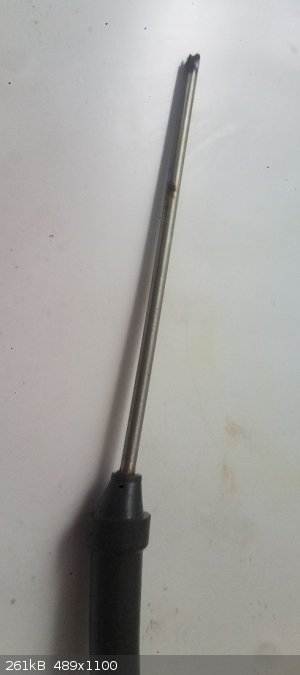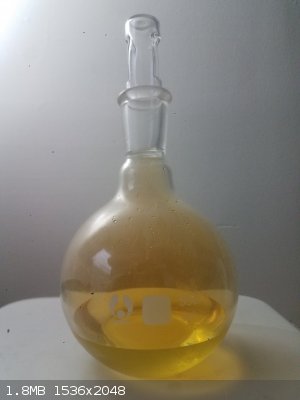| Pages:
1
2 |
Monte Carlo
Harmless

Posts: 2
Registered: 25-11-2013
Location: here
Member Is Offline
Mood: Stochastic
|
|
Persulfate for cleaner WFNA from atmospheric distillation (and as NO2 scavenger): US3113836
Ammonium persulfate is an excellent NO2 scavenger, useful both during distillation from sulfuric acid (whether using a nitrate salt or azeotropic
nitric acid) and for clarifying and stabilizing the distilled product.
The persulfate reacts with water and NO2 to make bisulfate and nitric acid, with a net reaction as follows:
(NH4)2S2O8 + 2 H2O + 2 NO2 ==> 2 NH4HSO4 + 2 HNO3
I have found that adding a small amount of ammonium persulfate (less than 1% of the weight of the nitrate source) to the pot seems to significantly
reduce the NO2 that comes over during fractional distillation at atmospheric pressure. (It also helps to exclude light from the parts of the
apparatus where HNO3 is hot -- the pot and the column -- by wrapping them in aluminum foil, which also acts as heat shielding for better
fractionation.)
The distilled product still has a yellow tinge which can be clarified to water-white either with a small amount of persulfate or urea.
The advantages and disadvantages are,
* Urea slightly dilutes the acid when scavenging NO2 (water is a byproduct), but it does not introduce any contaminating ions
* Persulfate actually scavenges water, dehydrating the acid while removing NO2, and even a tiny excess of persulfate also stabilizes the white fuming
nitric acid product during storage. However, persulfate does introduce a small concentration of contaminating ions. For most WFNA uses, this has no
impact.
The stabilization is described in patent US3113836.
|
|
|
Chemstacks
Harmless

Posts: 1
Registered: 13-7-2018
Member Is Offline
|
|
I have a question: Why are you using 225g KNO3 and 100mL of H2SO4? I have tried to calculate the necessary reagents needed and got different values:
(125mL HNO_3)/1 x 68/100 x (1..51g HNO_3)/(1 mL HNO_3 ) x (1 mol HNO_3)/(63.01g HNO_3 ) x (1 mol H_2 SO_4)/(1 mol HNO_3 ) x (98.08g H_2
SO_4 )/(1 mol H_2 SO_4 ) x ( ml H_2 SO_4 )/(1.84g H_2 SO_4 )=108 mL H_2 SO_4
(125mL HNO_3)/1 x 68/100 x (1..51g HNO_3)/(1 mL HNO_3 ) x (1 mol HNO_3)/(63.01g HNO_3 ) x (1 mol KNO_3)/(1 mol HNO_3 ) x (101.1 g
KNO_3)/(1 mol KNO_3 )=205.94 g KNO_3
The amount of sulfuric acid is close, but 8 mL difference is still a bit off. Also, I am not sure if my stoichiometry equation is right or its because
you are using pottery grade KNO3 so you needed more of it to compensate for its impurity?
My website dedicated to experiments and research in organic and analytical chemistry: www.chemstacks.com |
|
|
weilawei
Hazard to Others
  
Posts: 130
Registered: 3-12-2017
Member Is Offline
Mood: No Mood
|
|
I'm following MagPie's preparation, as written, with the addition of 1.18g (0.5% w/w% of the KNO3) ammonium persulfate. However, upon heating, the
temperature rose to ~80°C, distilling over a liquid from 67°C to 80°C. Then, the temperature started to swing wildly, down to 70°C, back up to
80°C, etc..
Any ideas what's going on? I've only collected maybe 20mL so far, but its never reached past ~80°C in 7 hours on a sand bath with insulation. The
sand itself reads 197°C, so that seems more than sufficiently hot even with heating losses. It was initially held at 135°C, but I was getting
nowhere, so I pushed it up to around 197°C, which is the rated maximum setting on my hotplate for a sand bath (#3 on the dial, the 197°C is just
where the temperature was measured). Eventually, I had to shut it down and go to work after pulling an all-nighter, so I'll heat it up again tonight.
Also, anyone have a vapor-liquid equilibrium chart with the temperatures and percentages marked on the axes for 760 Torr?
[Edited on 26-9-2018 by weilawei]
|
|
|
Magpie
lab constructor
    
Posts: 5939
Registered: 1-11-2003
Location: USA
Member Is Offline
Mood: Chemistry: the subtle science.
|
|
You shouldn't have to heat it so much. The azeotrope comes over at 120°C. Did you add the required amount of water?
The single most important condition for a successful synthesis is good mixing - Nicodem
|
|
|
weilawei
Hazard to Others
  
Posts: 130
Registered: 3-12-2017
Member Is Offline
Mood: No Mood
|
|
I added 100mL of H2SO4 to 48mL of water in an ice bath and let it cool.
I reheated it today after insulating more thoroughly. Same heat settings, though I have some question as to the veracity of the sand bath temperature;
the thermocouple probe looked pretty bad after I pulled it out. The last time a thermocouple got melted, the readings were unrealistically high.
I ran the distillation until it reached 114°C (density of 1.34g/mL at 28.4°C, 57.6% for the first fraction), then swapped receivers as it seemed to
not be climbing. The temperature dropped to around 110°C and never rose again. I ended heating when I saw heavy red clouds of NO2 puffing into the
condenser. Haven't measured density for the second fraction yet.
I'll definitely run this again. I'm thinking I'll do several runs, combine all the fractions, and do one final distillation to get 68% HNO3. I also
think I'll switch to an oil bath. As to insulation, that seemed critical, so maybe I'll get out the glass wool. I'd used Al foil this time--ultimately
in 3 layers.
Edit: Took the density of the second fraction, got 1.36 g/mL at 22.7°C, which is 61.0%. I'm satisfied with this as a first attempt. Certainly, my
technique could stand improvement, but the reaction worked with relatively little fuss. I did not suffer major issues with foaming or clogging--I
found it to be rather well behaved for such a solids-heavy slurry. I employed a dumbbell-shaped stirbar just in case. I found the microwave trick to
be extremely useful in cleaning my reaction flask. As for the thermocouple: it did not survive. A couple pictures, the thermocouple and the combined
fractions before the acid is transferred to an amber bottle.
 
[Edited on 29-9-2018 by weilawei]
|
|
|
jackchem2001
Harmless

Posts: 36
Registered: 2-6-2024
Member Is Offline
|
|
I tried out this procedure and experienced a problem. While initially the apparatus was fine and there was no NO2/HNO3 odor detectable (ground glass
joints greased with sulfuric acid and silicone grease used on tubing-glass interface), in the boiling flask the nitric acid/water seemed to condense
in and around the joints, eventually dissolving away the sulfuric acid grease. Eventually, some joints were slightly blown apart the once the nitric
acid in the joint began to boil. I had to stop the procedure early because of this.
Has anybody else encountered and successfully resolved this issue? I don't think clamping is a good idea in general but especially in this procedure
because it may foam over. My only ideas were:
- First grease the joints when cold and then use a heat gun to get them to perhaps 150 degrees and then insulate them well, which could hopefully
prevent condensation near the joint.
- Or perhaps use an air pump to encourage distillation at a lower temperature (not sure if this would really help here)
Also, you don't need to use an inverted funnel scrubber if you use an air bleed like this:

It's just a check valve attached on the 'closed' side of the apparatus (that is, before the scrubber). I always have one so I put a valve on it to
prevent corrosion when it's not being used (apparatus is not generating soluble gases and is not cooling down from boiling) but it's probably not
needed.
Unrelated but this is a good resource for NO2 poisoning information. It doesn't seem possible to accidentally poison yourself without realising (same
as Cl2). https://www.ncbi.nlm.nih.gov/books/NBK230446/
Interestingly, it doesn't seem to mention the anesthetizes nose claim presented on the wiki and while I found some other sources online mentioning the
same thing, I couldn't find a primary citation (but I didn't look very hard).
|
|
|
Sir_Gawain
Hazard to Others
  
Posts: 420
Registered: 12-10-2022
Location: Due South of Due West
Member Is Offline
Mood: Like a pendulum
|
|
Use PTFE tape for sealing joints. It’s cheap, and can withstand high temperatures and pretty much any chemical you can throw at it. Just wrap the
joints in a single layer with a little overlap between turns. I’ve been using it for a few years now and never had a joint seize up.
“Alchemy is trying to turn things yellow; chemistry is trying to avoid things turning yellow.” -Tom deP.
|
|
|
| Pages:
1
2 |